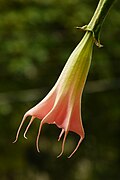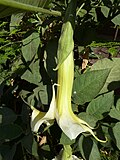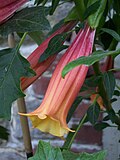Brugmansia
| Brugmansia | |
|---|---|

| |
| Brugmansia 'Feingold' | |
| Scientific classification | |
| Kingdom: | Plantae |
| Clade: | Tracheophytes |
| Clade: | Angiosperms |
| Clade: | Eudicots |
| Clade: | Asterids |
| Order: | Solanales |
| Family: | Solanaceae |
| Subfamily: | Solanoideae |
| Tribe: | Datureae |
| Genus: | Brugmansia Pers. |
| Species | |
|
See text | |
| Synonyms | |
|
Methysticodendron R.E.Schult. | |
Brugmansia is a genus of seven species of flowering plants in the nightshade family Solanaceae.[2] They are woody trees or shrubs, with pendulous flowers, and have no spines on their fruit. Their large, fragrant flowers give them their common name of angel's trumpets, adjacent to the nickname devil's trumpets of the closely related genus Datura.
Brugmansia species are among the most toxic of
Description

Brugmansia are large shrubs or small trees, with semi-woody, often many-branched trunks. They can reach heights of 3–11 m (10–36 ft). The leaves are alternately arranged along the stems, generally large, 10–30 cm (4–12 in) long and 4–18 cm (2–7 in) across, with an entire or coarsely toothed margin, and are often covered with fine hairs. The name "angel's trumpet" refers to the large, pendulous, trumpet-shaped flowers, 14–50 cm (6–20 in) long and 10–35 cm (4–14 in) across at the opening. They come in shades of white, yellow, pink, orange, green, or red. Most have a strong, pleasing fragrance that is most noticeable in the evening. Flowers may be single, double, or more.
Taxonomy
Linnaeus first classified these plants as part of Datura with his 1753 description of "Datura arborea". Then in 1805, C. H. Persoon transferred them into a separate genus, Brugmansia, named for Dutch naturalist Sebald Justinus Brugmans.[4] For another 168 years, various authors placed them back and forth between the genera of Brugmansia and Datura, until in 1973, with his detailed comparison of morphological differences, T.E. Lockwood settled them as separate genera, where they have stayed unchallenged since.[6]
Currently, there are seven recognized species:[7]
| Section | Image | Scientific name | Distribution |
|---|---|---|---|
| Brugmansia | 
|
Brugmansia aurea Lagerh. | Andes - Venezuela to Ecuador |

|
Barb.Rodr.) Lockwood ex R.E. R.E.Schult.
|
Eastern Andes foothills - Colombia to Bolivia and occasionally Brazil | |

|
Willd.) Sweet
|
Southeast Brazil | |

|
Brugmansia versicolor Lagerh. | Ecuador | |
| Sphaerocarpium | 
|
Brugmansia arborea (L.) Sweet | Andes - Ecuador to northern Chile |

|
D.Don
|
Andes - Colombia to northern Chile | |

|
Brugmansia vulcanicola (A.S.Barclay) R.E.Schult. | Andes - Colombia to Ecuador |
These species are then divided into two natural, genetically isolated groups.[8] Brugmansia section Brugmansia (the warm-growing group) includes the species aurea, insignis, sauveolens, and versicolor. Brugmansia section Sphaerocarpium (the cold group) includes the species arborea, sanguinea, and vulcanicola.[7]
Two of these species were challenged by Lockwood in his 1973 doctoral thesis.[9] First, Brugmansia vulcanicola was said to be a subspecies of B. sanguinea, but this was refuted by Lockwood's former mentor, R. E. Schultes in 1977.[10] Second, Lockwood proposed that the species B. insignis was instead a hybrid of the combination (B. suaveolens x B. versicolor) x B. suaveolens. This was later disproved by crossbreeding experiments done by the Preissels, published in 1997.[4]
Distribution and habitat
Brugmansia are native to tropical regions of South America, along the Andes from Venezuela to northern Chile, and also in south-eastern Brazil.[4] They are grown as ornamental container plants worldwide, and have become naturalized in isolated tropical areas around the globe, including within North America, Africa, Australia, and Asia.[11][12][13][14]
Ecology
Most Brugmansia are fragrant in the evenings to attract pollinating moths.[15] One species lacking scent, the red-flowered Brugmansia sanguinea, is pollinated by long-billed hummingbirds.[4] Brugmansia have two main stages to their life cycle. In the initial vegetative stage the young seedling grows straight up on usually a single stalk, until it reaches its first main fork at 80–150 cm (2.6–4.9 ft) high. It will not flower until after it has reached this fork, and then only on new growth above the fork. Cuttings taken from the lower vegetative region must also grow to a similar height before flowering, but cuttings from the upper flowering region will often flower at a very low height.[4]
One interesting example of plant/animal interaction involves the butterfly Placidula euryanassa, which uses Brugmansia suaveolens as one of its main larval foods. It has been shown that these can sequester the plant's tropane alkaloids and store them through the pupal stage on to the adult butterfly, where they are then used as a defense mechanism, making themselves less palatable to vertebrate predators.[16]
Brugmansia seed dispersal was probably formerly accomplished by mammalian megafauna, extinct since the Pleistocene. Brugmansia has long been extinct in the wild as their fruits now shrivel on the plants without progeny.[17] They have been maintained in cultivation as a source of psychotropic drugs, following the loss of their evolutionary seed dispersal partner by humans.[18]
Historical uses
Brugmansia are most often grown today as flowering ornamental plants.
Brugmansia contains
Brugmansia species have also traditionally been used in many
Several South American cultures have used Brugmansia species as a treatment for unruly children, so that they might be admonished directly by their ancestors in the spirit world, and thereby become more compliant. Mixed with maize beer and tobacco leaves, it has been used to drug wives and slaves before they were buried alive with their dead lord.[21][25][26]
In the Northern Peruvian Andes, shamans (
Toxicity
All parts of Brugmansia are potentially poisonous, with the seeds and leaves being especially dangerous.[23][29] Brugmansia are rich in
Effects of ingestion can include paralysis ofThe
In 1994 in Florida, 112 people were admitted to hospitals after ingesting Brugmansia,[36] leading one municipality to prohibit the purchase, sale, or cultivation of Brugmansia plants.[4][37][38] The concentrations of alkaloids in all parts of the plant differ markedly. They even vary with the seasons and the level of hydration, so it is nearly impossible to determine a safe level of alkaloid exposure.[31]
In 2022 The BMJ reported the following case: A woman in her 50s presented to the emergency department with blurred vision and pupil asymmetry for 3 hours. The right pupil was dilated, while the left was normal. A detailed history revealed that she had been pruning plants in her garden, when the blurred vision started. She did not complain of any other symptom. When all tests proved normal, she was finally asked to provide a photo of her garden. Brugmansia suaveolens (angel's trumpet) was identified in the picture. On asking specific history, she reported rubbing her right eye after touching the plant's leaves and flowers.[39] It shows that Brugmansia is highly toxic. Even touching the leaves and flowers can transfer sufficient amounts of active principles to the hand.
Cultivation
Brugmansia are easily grown in a moist, fertile, well-drained soil, in sun to part shade, in frost-free climates. They begin to flower in mid to late spring in warm climates and continue into the fall (autumn), often continuing as late as early winter in warm conditions. In cool winters, outdoor plants need protection from frost,[40] but the roots are hardier, and may resprout in late spring. The species from the higher elevations, in B. section Sphaerocarpium, prefer moderate temperatures and cool nights, and may not flower if temperatures are very hot. Most Brugmansia may be propagated easily by rooting 10–20 cm (4–8 in) cuttings taken from the end of a branch during the summer. Several hybrids and numerous cultivars have been developed for use as ornamental plants. B. × candida is a hybrid between B. aurea and B. versicolor; B. × flava is a hybrid between B. arborea and B. sanguinea; and B. × cubensis[8] is a hybrid between B. suaveolens, B. versicolor, and B. aurea. There are cultivars producing double flowers, and some with variegated leaves. The cultivars B. × candida 'Grand Marnier'[41] and 'Knightii' [42] have gained the Royal Horticultural Society's Award of Garden Merit.[43]
Gallery
-
Angel trumpets shrub – Brugmansia suaveolens
-
Brugmansia hybrid flower
-
Brugmansia suaveolens
-
Angel trumpets – Brugmansia suaveolens
-
Brugmansia × candida, Mangonui, North Island, New Zealand
-
Brugmansia vulcanicola flower
-
Brugmansia suaveolens flower
-
Mounts Botanical Garden, West Palm Beach, Florida
-
Brugmansia x candida, Berkeley, California, USA
-
Brugmansia, Nafpaktos, Northern Greece
-
Brugmansia cultivar ‘Culebra’ (formerly Methysticodendron amesianum) Kew Gardens
References
- ^ "Genus: Brugmansia Pers". Germplasm Resources Information Network. United States Department of Agriculture. 2009-09-01. Archived from the original on 2000-10-29. Retrieved 2010-09-25.
- ^ LCCN 2013031617. Archivedfrom the original on 2021-09-17. Retrieved 2021-09-17.
- ^ Resources, University of California Agriculture and Natural. "Toxic Plants (by scientific name)". ucanr.edu. Archived from the original on 2015-05-09. Retrieved 2015-05-07.
- ^ ISBN 1-55209-598-3.
- ^ "IUCN Red List: search on Brugmansia and select any of the species". Archived from the original on 2021-01-17. Retrieved 2020-08-09.
- from the original on 2018-12-14. Retrieved 2018-12-11.
- ^ ISBN 978-1-84246-477-9.
- ^ a b Shaw, J. M. H. (1999). "Nomenclature Notes on Brugmansia". The New Plantsman. 6 (3). Royal Horticultural Society: 148–151.
- OCLC 38575671.
- ^ Schultes, R. E.; Bright, A. (1977). "A Native Drawing of an Hallucinogenic Plant From Colombia" (PDF). Botanical Museum Leaflets. 25 (6). Cambridge, MA: Harvard University. Archived (PDF) from the original on 2012-04-26.
- ISBN 978-3-540-42429-1. Archivedfrom the original on 2014-06-02.
- ISBN 978-0-231-05780-6. Archivedfrom the original on 2014-05-23.
- ^ Kurniati, H.; et al. (November 2010). "Ecology, Distribution and Bio-acoustic of Amphibians in Degraded Habitat" (PDF). Archived from the original (PDF) on 2012-04-26. Retrieved December 5, 2011.
- from the original on 2014-01-03.
- ISBN 978-0-88192-661-3.
- ISBN 978-3-540-74540-2. Archivedfrom the original on 2018-02-17.
- ^ "Extinct in the Wild but Still Around: 5 Plants and Animals Kept Alive by Humans | Britannica". Archived from the original on 2020-07-18. Retrieved 2020-07-01.
- ^ Hirtz, Alexander. "The Latest Explosion in Orchid Evolution." Selbyana 26, no. 1/2 (2005): 277-87. Accessed July 1, 2020. www.jstor.org/stable/41760201.
- ^ Schultes, R. E. Ethnobotany and History of Brugmansia.
- ISBN 9780062503732.
- ^ S2CID 198152137.
- ISBN 978-0-8493-3664-5.
- ^ ISBN 978-1-4042-1140-7. Archivedfrom the original on 2014-01-07.
- ISBN 978-0-520-05569-8.
brugmansia children ancestors.
- ISBN 978-0-398-03863-2. Archivedfrom the original on 2017-03-21.
- ^ Royal Horticultural Society (Great Britain) (2004). "The Garden". 2004: 557.
{{cite journal}}: Cite journal requires|journal=(help) - ^ Campos, Don Jose (2011). The Shaman & Ayahuasca: Journeys to Sacred Realms.
- ISBN 978-1-4042-1040-0.
- LCCN 75646463.
- .
- ^ from the original on 2009-05-05.
- ISBN 978-1-4200-6252-6. Archivedfrom the original on 2018-02-17.
- ISBN 978-0-7637-3989-8. Archivedfrom the original on 2018-02-17.
- S2CID 12141800.
- (PDF) from the original on 2016-03-04.
- ISBN 978-0-306-45465-3. Archivedfrom the original on 2017-02-17.
- ^ "CODE, CITY OF MAITLAND, FLORIDA" (PDF). March 27, 2000. Archived from the original (PDF) on April 26, 2012. Retrieved December 20, 2011.
- ^ "Last blast for Florida's teenage trippers". Archived from the original on 2017-02-17.
- S2CID 247794970.
- ^ L. Grant, Bonnie (9 December 2015). "Brugmansia Cold Tolerance: How Cold Can Brugmansias Get?". Gardening Know-How. Archived from the original on 6 June 2019. Retrieved 6 June 2019.
- ^ "Brugmansia × candida 'Grand Marnier'". RHS. Retrieved 12 April 2020.
- ^ "Brugmansia × candida 'Knightii'". RHS. Retrieved 12 April 2020.
- ^ "RHS Plant Selector - Brugmansia × candida 'Grand Marnier'". Archived from the original on 7 August 2013. Retrieved 18 June 2013.
Further reading
- Hay, A., M. Gottschalk & A. Holguín (2012). Huanduj: Brugmansia English text, many diagrams and illustrations. ISBN 978-1-84246-477-9
- Gottschalk, Monika (2000). Engelstrompeten (German with English translation booklet). BLV Verlagsgesellschaft mbH. ISBN 978-3-405-15760-9
- Geit, Lars and Birgitta. Änglatrumpeter och spikklubbor Swedish text but photo rich. Small coffee-table book. ISBN 978-91-534-2511-3










